Radians
Categories: trigonometry radians

In real life, and GCSE maths, we usually measure angles in degrees. However, in more advanced mathematics we normally use radians. This article will look at what radians are, and why we use them.
Here is a video that explains radians:
Definition of radians
We usually define degrees in terms of right angles. A right angle, of course, is 90°, so 1° is one ninetieth of a right angle.
Radians are defined slightly differently, as this diagram shows:
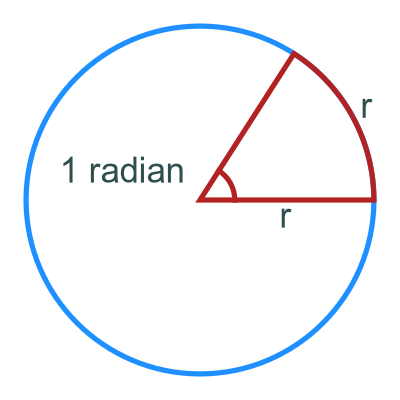
For a circle of radius $r$, if we draw an arc of length $r$, then the angle at the centre will be 1 radian. The angle of the sector shown is 1 radian.
Symbol for radians
Radians are sometimes abbreviated to rad, so we would write 2 radians as 2 rad. Often the symbol is omitted altogether, and an angle is assumed to be in radians unless the degree symbol is used.
Radians vs degrees
Since the circumference of a circle is $2 \pi r$, that means there are $2 \pi$ radians (approximately 6.28) in a full circle:

This means that $2 \pi$ radians is equivalent to 360°. 1 radian is therefore approximately 57.3 degrees.
To convert an angle measured in degrees, $d$, to the equivalent angle is radians, $r$, we use this formula:
$$ r = \frac{\pi}{180} d $$
To convert radians to degrees we can use this formula:
$$ d = \frac{180}{\pi} r $$
Here are some common angles expressed as radians:
| Degrees | Radians |
|---|---|
| 15° | $\pi/12$ |
| 30° | $\pi/6$ |
| 45° | $\pi/4$ |
| 60° | $\pi/3$ |
| 90° | $\pi/2$ |
| 180° | $\pi$ |
| 270° | $3\pi/2$ |
| 3600° | $2\pi$ |
Area of a sector
Since the total area of a circle is $\pi r^2$, and there are $2 \pi$ radians in a circle, it follows that the area of a 1 radian sector is:
$$ area = \frac{r^2}{2} $$
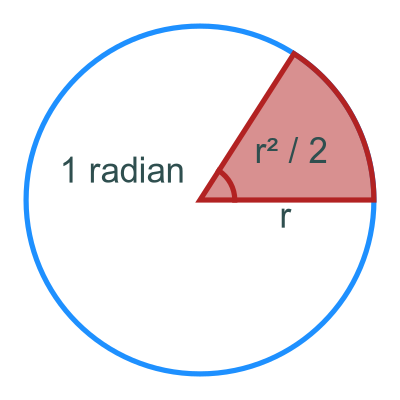
Unit circle
A circle of radius is called a unit circle. For a unit circle, a sector of angle 1 radian has:
- An arc length of 1.
- A sector area of 1/2.
These can be easily derived by setting $r$ to 1 in the formulae above.
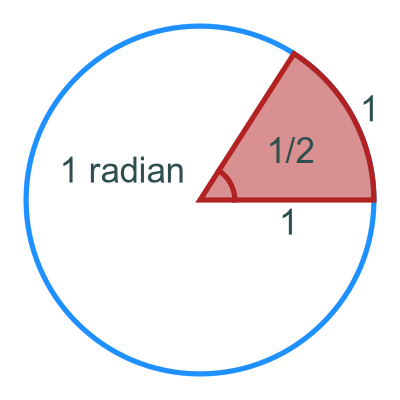
Benefits of using radians
The very simple relationship between angle, arcs and area in a circle are part of the reason radians are so useful. We will finish by looking at some other simplifications that radians bring. We won't derive any of these results here, they will be covered in other articles. This is just to give an indication of some of the benefits of using radians.
Here is the sine function, $\sin x$, where $x$ is measured in radians:
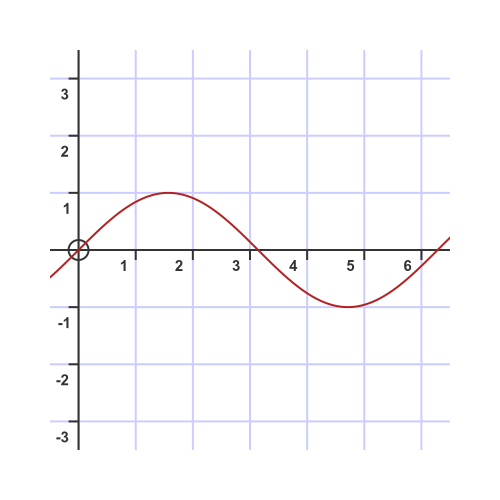
The slope of this curve at the origin is exactly 1:
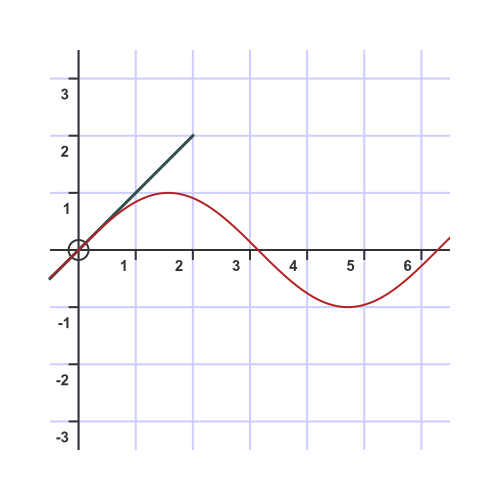
The area under the first lobe of curve is exactly 2:
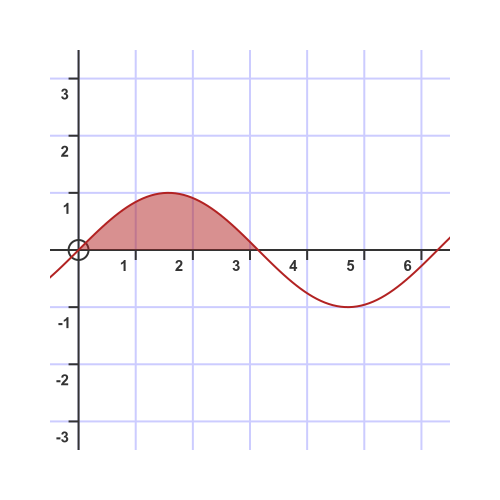
If we were to draw the graph with the angle measured in degrees, these slope and area values would need to be multiplied by a conversion factor so the result would be a lot less simple.
We can extend this. The slope of the sine curve at any point is equal to first derivative of $\sin x$, which is $\cos x$:
$$ \frac{\mathop{d}}{\mathop{dx}} sin x = cos x $$
The area under any part of the curve can be found from the integral of $sin x$, which is $-cos x$:
$$ \int \sin x \mathop{dx} = -\cos x $$
Again, these results only apply if angles are measured in radians. If we measure angles in degrees, the formulae still hold, but they need to have ugly conversion factors added.
The Maclaurin expansion allows us to express the sine function as an infinite polynomial:
$$ \sin x = x - \frac{x^3}{3!} + \frac{x^5}{5!} - \frac{x^7}{7!} + \frac{x^9}{9!} ... $$
Once again this function becomes ugly if $x$ is measured in degrees.

Join the GraphicMaths Newletter
Sign up using this form to receive an email when new content is added:
Popular tags
adder adjacency matrix alu and gate angle answers area argand diagram binary maths cartesian equation chain rule chord circle cofactor combinations complex modulus complex polygon complex power complex root cosh cosine cosine rule countable cpu cube decagon demorgans law derivative determinant diagonal directrix dodecagon eigenvalue eigenvector ellipse equilateral triangle euler eulers formula exercises exponent exponential exterior angle first principles flip-flop focus gabriels horn gradient graph hendecagon heptagon hexagon horizontal hyperbola hyperbolic function hyperbolic functions infinity integration by parts integration by substitution interior angle inverse hyperbolic function inverse matrix irrational irregular polygon isosceles trapezium isosceles triangle kite koch curve l system line integral locus logarithm maclaurin series major axis matrix matrix algebra mean minor axis n choose r nand gate net newton raphson method nonagon nor gate normal normal distribution not gate octagon or gate parabola parallelogram parametric equation pentagon perimeter permutations polar coordinates polynomial power probability probability distribution product rule proof pythagoras proof quadrilateral questions radians radius rectangle regular polygon rhombus root sech segment set set-reset flip-flop sine sine rule sinh sloping lines solving equations solving triangles square square root standard curves standard deviation star polygon statistics straight line graphs surface of revolution symmetry tangent tanh transformation transformations trapezium triangle turtle graphics uncountable variance vertical volume volume of revolution xnor gate xor gate